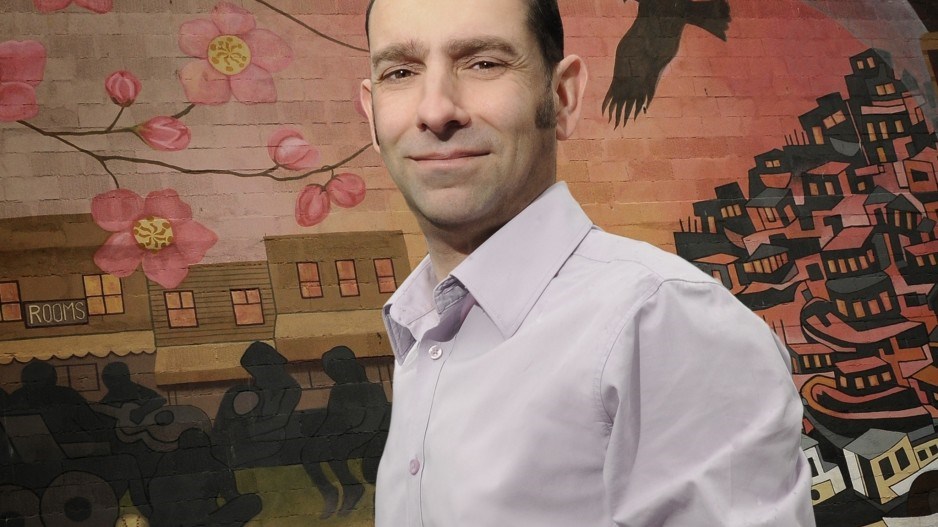Jonathan Oldman still remembers when his career plan veered sideways.
It was the early 1990s, and Oldman, in his twenties, was a hospital management trainee in London, England. Working with a public health physician as part of the program, he was introduced to a grittier sphere of influence.
“[The physician] said, ‘Yeah, hospitals – they’re OK,” remembered Oldman, now 43. “But the real action, she says – the real place where determinants of health [are set], where community is built – is out in the streets in the community services.”
Visiting mental health clinics, homeless shelters, community centres and housing estates, Oldman developed a passion for community services that would lead him off the hospital-management track – and eventually into his current role as executive director of Vancouver’s St. James Community Service Society.
Oldman said the drive behind his ambition to work in community services has been twofold.
“It got me both in a sort of emotional place, which was: this is what is fundamentally wrong with our communities. This is stuff that we have to get right, as a civilized society,” he said. “And it got me in an intellectual place because it made me think, and still makes me think: there are solutions to this. We know how to end homelessness. We know how to end isolation and poverty for seniors. We know how to give people a dignified and pain-free end of life. But it’s the managerial, political – small p, big p – organizational challenges that get in our way.”
Oldman arrived in the Lower Mainland in 1997 when he was 29 to take a job with the Vancouver- Burnaby branch of the Canadian Mental Health Association(CMHA).
He “burst onto the scene” is how Mark Smith puts it. Smith is executive director of RainCity Housing and Support Society, a fellow non-profit society and near neighbour of St. James in the Downtown Eastside.
“[Oldman] was younger, he was articulate, he was unafraid to speak his mind, although he was meeting with people that had been around forever and were sort of stodgy and staid,” Smith remembered. “And he would be challenging, but always in a respectful, gentle way.”
Within two years, Oldman was executive director of the CMHA branch. In that role, he focused first, as he would later do at St. James, on strengthening the organization’s administrative capacity to make it more effective.
“I’m not a physician, I’m not a nurse, I’m not a social worker,” he said. “So the value that I try to bring to the sector is about creating strong organizations.”
Under seven years of Oldman’s leadership, the CMHA branch became one of the Lower Mainland’s first players to launch social enterprises staffed with people recovering from mental illnesses.
Oldman said there were some false starts, but also “tremendous successes,” including the Cleaning Solutionjanitorial company, which was incubated within CMHA.
St. James’ search for an executive director caught Oldman just as he was looking for a “larger canvas” for his leadership aspirations. St. James had a staff of approximately 250 compared with CMHA’s approximately 50. Moreover, St. James was struggling.
From Smith’s vantage point working in the sector, he said St. James had “lost its moral compass” and was “uncertain of its mandate.”
It was the challenge that Oldman had been looking for.
“I think organizations are fascinating when they have tremendous assets and value but they’re underperforming – or they’re not performing to their true potential,” Oldman said.
Oldman became St. James’ executive director in 2008 and set about sharpening the organization’s strategic focus. “We did something which I think is quite unusual in the not-for-profit sector – which is get out of business,” he said.
Oldman said that over the course of two or three years, St. James pulled back from non-core programs such as youth services to focus on core offerings that included services for homeless women and children and the terminally ill.
Oldman added that he’s brought in a substantially new leadership team and strengthened St. James’ administrative capacity. He said that while funding administration is sometimes seen as a “dirty” concept in the non-profit sector, it’s crucial for delivering results.
In Oldman’s five years of leadership, he said St. James’ financial situation has improved, with fundraising revenue up 30%. He said that the organization is also now delivering more – and more positively reviewed – services.
But Oldman is quick to spread the praise for St. James’ turnaround.
“You’ve got to have people around you, whether that’s mentors, the team that you recruit, the board that you work for – it’s all about surrounding yourself with great people who make you look good and make the organization look good.”
Oldman is also quick to add that the work at St. James isn’t done. He said he’s pursuing external standards accreditation for St. James through the Commission on Accreditation of Rehabilitation Facilities Canada and will continue pushing development projects such as the conversion of the former remand centre in the Downtown Eastside into 95 units of affordable housing.
Beyond that, Oldman said he’s keen to link St. James’ services with other parts of the non-profit community. He hopes to drive collaborative, bigger-picture solutions in the Downtown Eastside.
“The challenge for our sector and for the community is to say ‘How do we have substantial impact on large social problems rather than just managing individual bits?’” •




